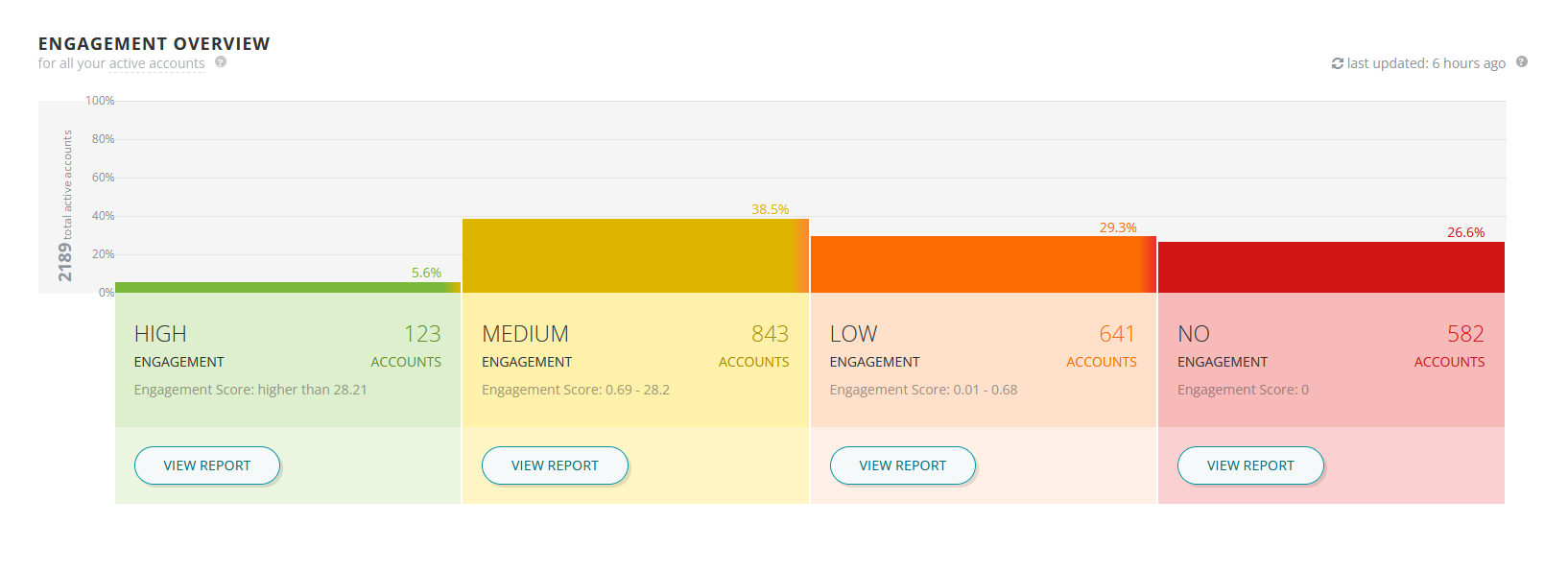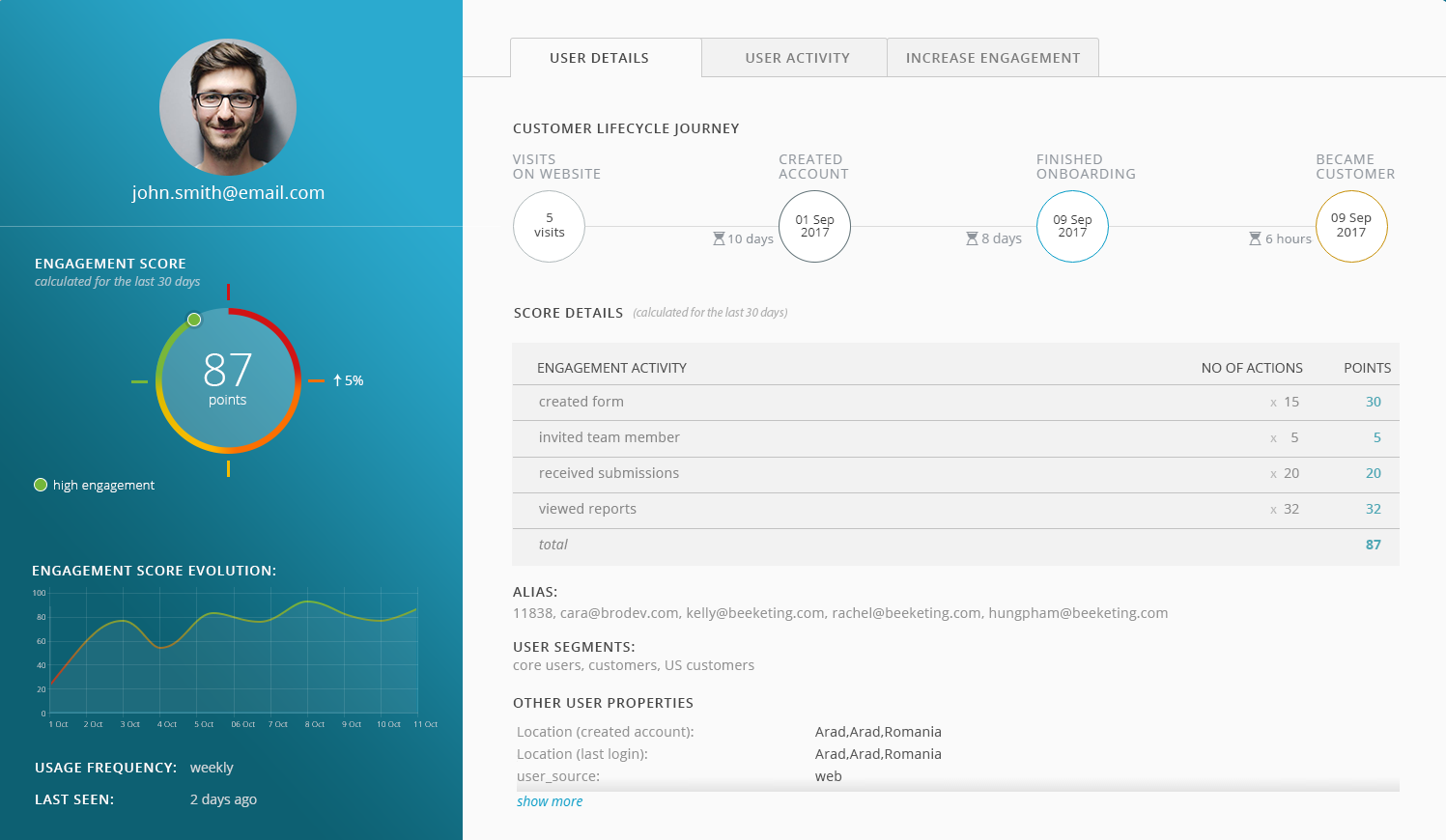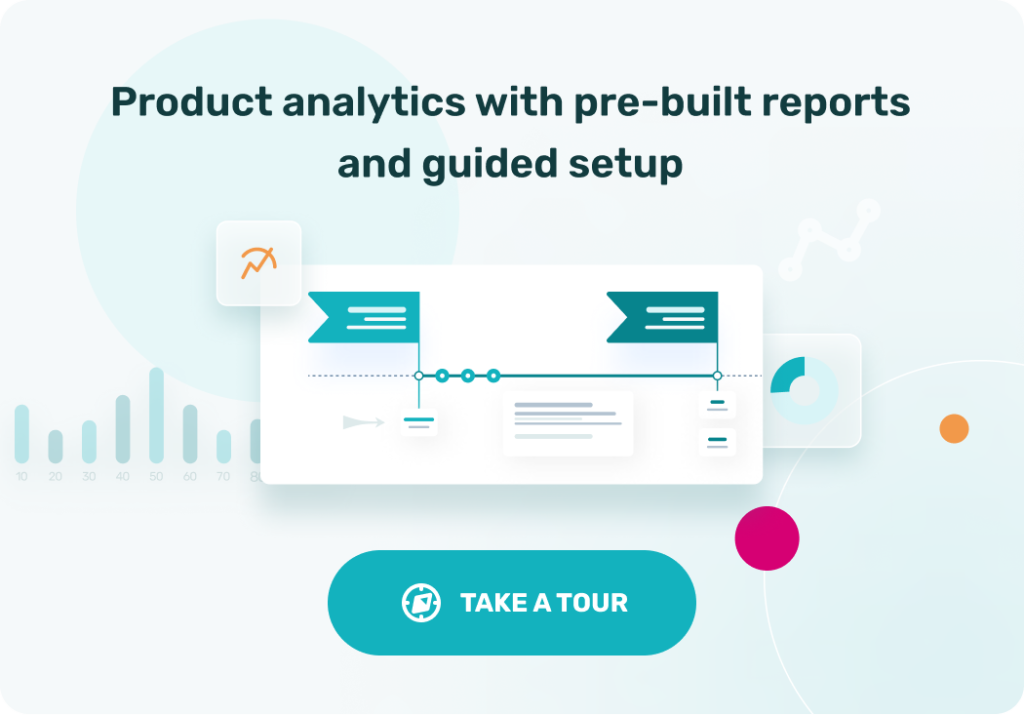Your customer engagement score can predict churn and indicate overall product health.
What’s a customer engagement score?
To put it simply, an engagement score is a metric that shows how engaged your customers are with your app.
It’s one of the best churn predictors, because the correlation between churn and engagement is high. When engagement goes down, retention goes down, and vice versa.
Engagement scoring is also a good indicator of product health, and can help you drive your product-led strategy.
Your customer engagement score can help you pinpoint customers that:
- Are ready to upgrade to a paid package;
- Need help or are about to churn;
- Are ready for an upsell or cross-sell;
- Are great candidates for writing reviews – ideally in correlation with your NPS score
By knowing the engagement score and using automated notifications, you can:
- Prevent churn while users are still active;
- Improve customer experience and satisfaction with your product;
- Augment your customer advocacy campaigns.

How is the engagement score calculated?
Normally, I love spelling out formulas. x = y/z and so on. In the case of the engagement score, the formula is a whole algorithm that we developed at InnerTrends as part of our pre-built product analytics reports.
What I can reveal is that, when it comes to engagement scoring, the InnerTrends product analytics solution takes two main factors into consideration:
- The number of engagement actions performed in the last 30 days
- The frequency with which those actions were performed
At InnerTrends we calculate the engagement score for each account on a daily basis, which allows you to monitor the movements of engagement in your user base so that you know who is increasing engagement and who is decreasing.
What actions are considered engagement actions?
Engagement should always be linked to the value your product is offering to your users. If somebody simply logs in to an account, we don’t consider that engagement. They need to do something that is directly linked to generating value.
This is why we have a strict framework for defining engagement actions by answering the following two questions:
- What are the main reasons your customers are using your product?
- What are the actions that help your users achieve their goals?
For example, with InnerTrends, these events are set as engagement actions during the setup of your account, or any time after by updating your Customer Journey Metrics map.
Note: When a user simply logs in to their account but performs no other action(s), the account is deemed active, but without engagement.
For an account to start receiving engagement points, they need to perform the events you defined by answering the above questions.
How is the engagement level calculated?
InnerTrends calculates the engagement level of all active accounts for any client in the last 30 days by splitting them into four categories:
- High engagement
- Medium engagement
- Low engagement
- No engagement

Engagement overview report, InneTrends product analytics platform
Here’s how the four engagement levels are generated:
- Accounts with no engagement have not performed any engagement actions in the past 30 days, though they used your product.
- The low engagement level is represented by the accounts that have a high churn rate. The upper threshold is calculated based on the engagement score of the accounts that churned in the past.
- Accounts with medium engagement are accounts with regular activity and have a small churn risk.
- High engagement is represented by the outliers, those that engage with your platform considerably more than the rest of your accounts.

Engagement level of each user, InnerTrends product analytics platform
Know which accounts are getting value, and which are about to churn
The engagement score of an account should be calculated daily, based on the last 30 days of engaged activity. If the new score fits a new engagement level, the user will be moved to that level.
The next step is to determine when users move from one category to another. And usually, they move a lot.
For instance, for a company with 300 active users/month, about ten of them will change categories every day.
For companies with thousands or tens of thousands of accounts, you can expect tens or even hundreds of users to change their engagement level every single day.
You definitely want to monitor decreasing engagement scores, because someone who goes from high to medium engagement, and then to low engagement will considerably increase their churn risk.
But, because they’re still active, you can still interact with them; you don’t need to recover them after they’ve left. The best thing to do is to find out the problem and fix it, and thus prevent them from leaving.
InnerTrends syncs the account’s engagement changes with your CRM and marketing automation platforms. These changes will trigger automatic notifications that can help further improve retention, prevent churn, and so on.
We recommend coupling customer engagement scoring with the customer’s stage: during / after onboarding, before / after becoming a paying customer.

Actions you can take based on the account’s engagement level – examples
Actions you can take for accounts that move into high engagement:
- Ask for a review, testimonial, or to recommend you to a peer.
- If they finish the onboarding process, ask for an upgrade.
- Offer access to beta features.
For accounts with medium engagement:
- Target with success stories specific to their persona to show how they can get more value from your product.
For accounts with low engagement:
- Send activation emails for accounts that have not finished onboarding and have low engagement rates.
- Get on a call with them if they fall from high to low engagement. Especially when they have just paid and their engagement level is going down, it’s a clear sign that something went wrong.
- Analyze their feature usage to discover possible friction points.
For accounts with no engagement:
- Target them with case studies, workshops, or educational content.
Key Takeaways
The bottom line is, with engagement scoring you can:
- Identify the users who are most likely to churn in the near future.
- Automate churn reduction campaigns triggered by changes in user engagement.
- Identify the minimum set of actions required to decrease a user’s churn risk.
- Find out who your most engaged customers are and the ideal time to ask them for reviews or recommendations.

